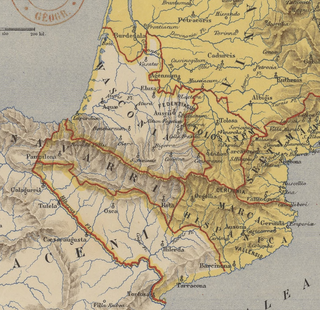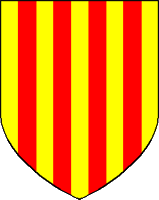Notes
Sources
- Lewis, Archibald R. (1965). The Development of Southern French and Catalan Society, 718–1050. Austin, TX: University of Texas Press.
This article relies largely or entirely on a single source .(November 2015) |
William of Septimania (29 November 826 – 850) was the son of Bernard and Dhuoda. He was the count of Toulouse from 844 and count of Barcelona from 848.
The sources for his life are primarily the Annales Bertiniani and the Chronica Fontanellensis , while his mother wrote an educational instruction book called the Liber Manualis for him and his brother sometime before February 842.
William was initially sent to the court of his uncle, Theodoric of Autun, who died around 830, and left the child in the charge of Louis the Pious, then reigning emperor. When Louis died in June 840, custody of the youth passed to Charles the Bald of West Francia. Throughout most of this time, William lived in Uzès, with frequent stays with his father in Toulouse. On 25 June 841, the same day as the Battle of Fontenoy, William petitioned Charles the Bald for investiture of the benefices of his godfather Theodoric in Burgundy. This was granted and the young William was invited to live at the royal palace, being promised investiture with the county of Autun in the future. When, however, Guerin of Provence was installed in Autun, dissension ripped apart the court.
William's father was dispossessed of his benefices, offices, and titles in July 842 and they were not passed to William. In May 844, his father was executed and he promptly joined the rebellion then under way in Aquitaine led by Pepin II. In June, he fought in the Battle of Angoumois. Pepin invested him with Toulouse, while Charles installed Fredelo there. It has been hypothesised that William was also the same person as the count of Bordeaux and possible duke of Gascony appointed by Pepin in 845. At that time, the Vikings invaded Aquitaine and ravaged as far as Limoges. As Ghilyam ibn Burbat ibn Ghilyam, he and several allies are said by chronicler Ibn Hayyan to have visited Córdoba in 846, seeking assistance from Abd al-Rahman II against Charles. [1] In 847, Vikings again besieged Bordeaux, and when William came to the city's relief he was captured. Finally liberated in 848 through an accord signed by Pepin, William returned to Gothia to lead the ongoing revolt there.
In that year, William entered Barcelona and Empúries and assumed authority there, "more by cunning and lies than by force of arms," according to the chroniclers. It has been supposed that Sunifred I of Barcelona died a natural death and Charles the Bald nominated Aleran to succeed him, but William, not recognising this, laid claim to the counties of Sunifred as the heir of Bernard. He asserted these rights and was recognised in the counties themselves. However, the sudden disappearance of Sunyer I of Empúries and Bera II of Conflent has led some scholars to posit an act of treachery ( coup d'état ) to secure his claimed inheritance. Following his successes, William wrote a letter of thanks to Abd al-Rahman, who in turn urged his lords on the Upper March to assist and support the Toulousain count, who again visited the Córdoban court. [1]
In summer 849, when Charles the Bald decided to attack Aquitaine, Fredelo welcomed him with open gates at Toulouse and the king reconfirmed Fredelo's investiture. Pepin fled in haste and Charles marched to Narbonne, where he named Aleran as count in Barcelona, Empúries, and Roussillon and as Margrave of Septimania. He granted Wilfred the counties of Girona and Besalú, and Solomon those of Cerdanya, Urgell, and Conflent. Aleran, who was possibly also the count of Troyes and son of William I of Blois, appointed an adjunct, Isembard, son of Guerin of Provence, given that he had to guard against William's territorial aspirations. In the end, Charles' nominations had little trouble taking up their charges.
In February 850, when Charles the Bald marched into Aquitaine and the nobles en masse switched allegiance to Pepin II, Sancho II Sánchez of Gascony took control of Bordeaux, and William marched over Catalonia. [2] Charles sent reinforcements and William was defeated in battle. William fled to Barcelona, where he was caught and killed by the royal partisans. [2] William was reportedly still in possession of his mother's Manual when he died. [3] In Barcelona, Sancho and his brother-in-law Emenon were captured by Musa ibn Musa of the Banu Qasi. In 851, the Moors occupied Barcelona, decimating the population. In September 852, Sancho was released by a treaty.
This article relies largely or entirely on a single source .(November 2015) |

Year 848 (DCCCXLVIII) was a leap year starting on Sunday of the Julian calendar.

Septimania is a historical region in modern-day Southern France. It referred to the western part of the Roman province of Gallia Narbonensis that passed to the control of the Visigoths in 462, when Septimania was ceded to their king, Theodoric II. The region was also variously known as Gallia, Arbuna or Narbonensis. Septimania territory roughly corresponds with the modern French former administrative region of Languedoc-Roussillon that merged into the new administrative region of Occitanie. Septimania was conquered by the Muslims in the 8th century, when it was known as Arbuna and was made part of Al-Andalus. It passed briefly to the Emirate of Córdoba, which had been expanding from the south during the eighth century, before its subsequent conquest by the Franks, who by the end of the ninth century termed it Gothia or the Gothic March.

The Hispanic March or Spanish March, also known as the March of Barcelona, was a military buffer zone beyond the former province of Septimania, established by Charlemagne in 795 as a defensive barrier between the Umayyad Moors of Al-Andalus and the Frankish Carolingian Empire.
Gaucelm was a Frankish count and leading magnate in Gothia during the reign of Louis the Pious. He was initially the Count of Roussillon from about 800, but he received Empúries in 817 and was thenceforward the chief representative of imperial authority in that region.
Bernardof Septimania (795–844), son of William of Gellone, was the Frankish Duke of Septimania and Count of Barcelona from 826 to 832 and again from 835 to his execution. He was also count of Carcassonne from 837. He was appointed to succeed his fellow Frank Rampon. During his career, he was one of the closest counsellors of the Emperor Louis the Pious, a leading proponent of the war against the Moors, and opponent of the interests of the local Visigothic nobility.
Berengar, called the Wise, was the count of Toulouse (814–835) and duke of Septimania (832–835). He held the County of Barcelona concomitantly with Septimania.
Sunifred was the Count of Barcelona as well as many other Catalan and Septimanian counties, including Ausona, Besalú, Girona, Narbonne, Agde, Béziers, Lodève, Melgueil, Cerdanya, Urgell, Conflent and Nîmes, from 834 to 848 and from 844 to 848 (others).
Bernard II was the count of Barcelona, Girona and margrave of Gothia and Septimania from 865 to 878.

This is a list of the counts of Roussillon who ruled over the eponymous County of Roussillon.
The County of Cerdanya was one of the Catalan counties formed in the last decades of the 8th century by the Franks in the Marca Hispanica. The original Cerdanya consisted of the valley of the upper Segre. Today Cerdanya is a Catalan comarca.
Sancho II Sánchez or Sans II Sancion succeeded his brother Aznar Sánchez as count of Vasconia Citerior (Gascony) in 836, in spite of the objections of King Pepin I of Aquitaine.

The Duchy of Gascony or Duchy of Vasconia was a duchy located in present-day southwestern France and northeastern Spain, an area encompassing the modern region of Gascony. The Duchy of Gascony, then known as Wasconia, was originally a Frankish march formed to hold sway over the Basques. However, the Duchy went through different periods, from its early years with its distinctively Basque element to the merger in personal union with the Duchy of Aquitaine to the later period as a dependency of the Plantagenet kings of England.
Fredelo, Fridolo, or Frigidolo was the first Count of Toulouse (844–852) of the dynasty of Rouergue.
Raymond I was the Count of Limoges, Rouergue and Quercy, and Toulouse and Albi. He was the younger son of Fulcoald of Rouergue and Senegund, niece of William of Gellone through his sister Alda.
Guerin, Garin, Warin, or Werner was the Count of Auvergne, Chalon, Mâcon, Autun, Arles and Duke of Provence, Burgundy, and Toulouse. Guerin established the region against the Saracens from a base of Marseille and fortified Chalon-sur-Saône (834). He took part in many campaigns during the civil wars that marked the reign of Louis the Pious (814–840) and after his death until the Treaty of Verdun (843). The primary sources for his life are charters and chronicles like the Vita Hludovici.

The County of Razès was a feudal jurisdiction in Occitania, south of the County of Carcassonne, in what is now Southern France. It was founded in 781, after the creation of the Kingdom of Aquitania, when Septimania was separated from that state.
Wilfred or Wifred, called the Hairy, was Count of Urgell, Cerdanya, Barcelona, Girona, Besalú and Ausona. On his death in 897, his son, Wilfred Borrell, inherited these Catalan counties.
The Battle of Toulouse in 844 was part of the campaign by Charles the Bald in Aquitaine to force the submission of Pepin II of Aquitaine, the rebellious son of Pepin, the half-brother of Charles. The historical context of this battle is the three-year Carolingian civil war, culminating in the Battle of Fontenay-en-Puisaye in 841. Here Charles and Louis the German defeated their brother Lothair I, who retreated to the south with his army.
A Jewish Princedom in Feudal France, 768–900 is a book about Frankish medieval history by Arthur J. Zuckerman.
The siege of Barcelona was a military operation by a Carolingian army with the aim of conquering the city of Barcelona, which had been under Muslim control for 80 years. The siege and conquest were part of the expansion of the Marca Hispanica and the constitution of the County of Barcelona by the Carolingians.